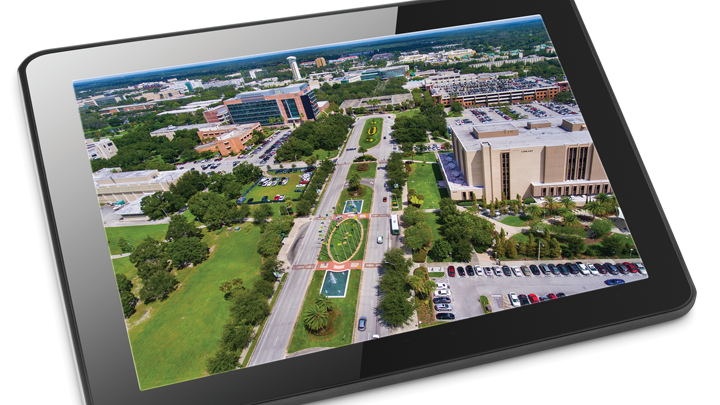Current Features
Behind the Scenes
– USF RESPONDS: COVID-19 –
By Tom Woolf

THE SPRING SEMESTER ACROSS USF’S THREE CAMPUSES was filled with the normal activities of university life – lectures and quizzes; faculty holding office hours; students meeting with advisors; faculty and staff meetings; group fitness classes; intramural sports.
Except that “normal” took on a whole new meaning.
The coronavirus pandemic suddenly sent USF faculty, staff and students into an online world. Teaching and learning and student services went virtual. Most everything did – from doctoral defenses to departmental baby showers, from career fairs to a 5K run (which drew nearly 800 participants). The spring semester ended with a first-ever virtual commencement for nearly 7,500 members of the Class of 2020.
As the pandemic spread across the country in early March, an email to faculty from Ralph Wilcox, USF’s provost and executive vice president, set the stage for what was to come.
“As we seek to provide educational access to students outside the classroom, as may become necessary, we are developing instructional resources, support and technological alternatives to face-to-face course delivery, utilizing our learning management tool, ‘Canvas,’” he wrote.
Behind the scenes, Innovative Education and Information Technology mobilized to transition more than 5,200 courses to remote instruction following spring break in March. It was, in the words of Cindy DeLuca, who leads Innovative Education, “a herculean effort.”
The effort included the creation of online toolkits to help guide faculty and students through the transition. Using multiple online workshops and chats with instructors, DeLuca’s team helped faculty prepare during the week of spring break. Under normal circumstances, a learning designer works with a faculty member for at least one full semester to develop a course for online design and delivery.
As DeLuca, associate vice president and assistant vice provost, explains it, “The design process includes organizing the course structure, creating meaningful interaction between the faculty and their students, using the most appropriate mix of technologies to develop innovative and interactive content, aligning learning objectives, content and assessment, and ensuring the course is accessible and follows national standards for best practices in online course development.”
And, while 35 percent of faculty have been certified to teach online, “there was still a large percentage who had no prior experience in the online modality,” she adds.
Those who did have online teaching expertise also played an important role in helping less-experienced faculty make a successful transition.
“Faculty who had gone through our traditional design and development process became college experts who guided their colleagues in the use of tools, teaching approaches and best practices in online learning,” DeLuca says. “Quality course design … this is what my team focuses on every day in Innovative Education. Online teaching was new for many faculty members, and we were impressed with how the faculty came together to transition their courses to remote delivery while staying true to our core value of student success.”
Also central to the successful transition to the virtual world were the 450 members of the Information Technology team.
“We accelerated all of the strategies that we had planned to do in a semester, in a week,” Sidney Fernandes, vice president and chief information officer, says, adding that IT lived by the hashtag “#InaWeek”.
“We had to take a workforce that was primarily at a singular location and enable them to work as if in an office, but at home,” he says. “We had to make sure students who were used to being in class and getting services in person could do all of that from home. We have agile teams, and they were functioning at peak capacity while being remote.”
A crucial element in maintaining continuity for faculty, staff and students was moving everyone to Microsoft Teams, a secure, cloud-based chat and group collaborative workspace. IT had moved USF Health to that platform last fall and planned to transition all USF students later this summer.
“We moved more than 50,000 student accounts, as our hashtag says, in a week,” says Chief Technology Officer Patrick Gall, ’06.
While that effort was a success, the IT team also knew the new communications platform would likely mean the now-remote Help Desk would have to field many questions.
“We knew it would be inundated,” Gall says, noting volunteers were recruited from across IT and temporary staffing was arranged as well.
The Help Desk experienced the predicted increase in call volume when classes resumed after spring break, responding to 1,000 inquiries per day compared to a normal volume of 200.
There were other needs to meet as well, including development of an institution-wide laptop/webcam loan program for faculty and students. That was accomplished through a collaborative funding effort involving IT, Student Government and the USF Libraries.
“The supply chain was disrupted, nothing was coming out of China,” says Beth Reid, director of business operations for IT. “If you wanted computers, you had to act quickly and you got what you got. We were able to secure 130 laptops for students at very good prices. Then we had requests from some students for webcams, and we were able to find some. We found another 40 laptops for USF Health’s practice plan after they discovered some of their desktops didn’t have WIFI capability.”
A request from a college dean prompted Fernandes and his team to create a process for students to schedule virtual drop-in appointments with advisors. Another application had to be created – within three days – to facilitate the new pass/fail system for courses. Approval of the federal CARES Act necessitated another new application so students could apply for financial assistance. Using Microsoft Teams, IT helped USF Health implement telehealth so patients could consult remotely with physicians.
“Given all of the variables of what could have gone wrong with all of these new processes, we believe this has gone relatively well,” Fernandes says. “We’ve solved problems. The clients we have spoken with have said this whole transition has gone way better than they might have expected.”